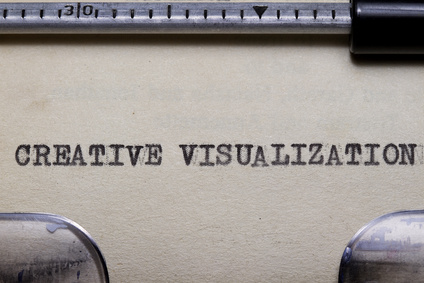


Introduction
Visualization
Guided Imagery & Psychoimmunology
Meditation
Self-hypnosis
Introduction to Altered States
Visualization, Guided Imagery, Meditation, and Self-hypnosis can be applied in virtually limitless ways to support health, healing, positive change and transformation. Each method derives its potential by means of an altered state of consciousness. Within the altered state realm exist many, perhaps even infinite opportunities for healing explorations and experiences to emerge. Accessing an altered state of consciousness allows you to transcend the limitations and restrictions of the rational mind with its years of self-limiting conditioning and programming with regard to what is "real" and, more importantly, what is possible.
Visualization, guided imagery, meditation, and self-hypnosis all share two things in common: 1.) Each is a subjective/lived experience; and, 2.) Each employs the use of an altered state of consciousness. Beyond that the similarities begin to diverge in subtle but fundamental ways. One method is not better than another, for each serves a particular purpose offering a unique set of benefits and experiences. Each method can serve a key role in the health, healing, and transformation process.
Learning the techniques of altered state work, inner work, and self-exploration through private instruction greatly accelerates results and provides the most direct and efficient way to enhance personal growth and development. Through private instruction you and the facilitator, or guide, work together to discover the methods and techniques that are most suited to your situation, interests, needs, desires, and objectives. Each method provides a clear and direct way to unlock and work with the incredible potential of the mind in creative and purposeful ways.
Working effectively in an altered state of consciousness offers many opportunities for healing, self-discovery, and transformation to unfold. An entire inner universe is awaiting your discovery! About the only limitations are those that are self-imposed by your own mind. You can use altered states of consciousness for healing, Self-discovery and exploration, parts therapy, inner peace and acceptance, alchemical and archetypal healing, generating awareness, life direction and inner answers, projecting backward or forward in time, and even remote healing for friends and loved ones. (back to top)
Visualization
 Many people who can greatly benefit from visualization don't bother to do so because they are convinced that they are not visual or cannot visualize correctly. The term "visualization" causes confusion regarding what the experience of visualization is like. The very term implies that you are supposed to "see" visual pictures and images in vivid color and exacting detail. Some people experience visualization in this way; the majority of people do not.
Many people who can greatly benefit from visualization don't bother to do so because they are convinced that they are not visual or cannot visualize correctly. The term "visualization" causes confusion regarding what the experience of visualization is like. The very term implies that you are supposed to "see" visual pictures and images in vivid color and exacting detail. Some people experience visualization in this way; the majority of people do not.
Visualization is more correctly thought of as perceiving or simply receiving inner impressions. The impressions are sometimes nothing more than a clearly formed thought or idea. The "visualization" you receive can come to you in the form of thoughts, intuitive feelings, inner sounds, or even as a simple "knowingness" that is hard to accurately describe in words.
You can use the following exercise to explore how you receive inner impressions. To do so, read the following questions one at a time; then close your eyes and observe how the answers (inner impressions) come to you. Take time to notice and observe the details of the setting or situation presented by the questions. Notice how the images, forms, shapes, structures, and colors of your visualization experience show up in your field of awareness.
1.) What color was your first car? In your mind, "see" in detail what it looked like. Visualize with as much clarity as you can. What did the exterior and the interior of your first car look like?
2.) Go back in your mind to your grade school years. What did your clothes look like? Look in the mirror and visualize what your hairstyle looked like. What did your room look like? What did your town, school, and 6th-grade classroom look like?
3.) Recall a good movie you've seen recently. Where did you see the movie? Visualize some scenes from the movie and visualize what takes place.
4.) Play a song that you enjoy listening to. With your eyes closed, visualize the essence of the song in your mind. What images come to you? If you could make any type of music video for the song, what would it look like? What visual elements best represent and bring the song to life?
5.) Visualize scenes from an enjoyable vacation you have taken. Visualize traveling and being there. Where were you? What did the setting look like? What did you do? Was anyone with you?
There are an incredible number of ways to use visualization to enhance and facilitate health, healing, and wellness; including:
- Creating a special place you can go to and visit whenever you choose in order to experience inner comfort, peace, and tranquility.
- Seeing and inwardly experiencing yourself and your body healed.
- Using visualization to detach from, objectify, and dialog with pain, illness, disease.
- Traveling forward or backward in time to obtain insight and awareness on important matters that relate to health and healing today.
- Healing the mind, body, and emotions with energy using various forms, shapes, and colors.
- Contacting and developing conscious relation to the different parts of one's Self, including The Healer.
- Detaching and inwardly distancing oneself from unrelenting difficult situations or circumstances to restore balance and regain inner strength. (back to top)
Guided Imagery & Psychoimmunology
 Guided imagery and psychoimmunology are specific and focused forms of visualization that are most commonly used to support healing of the physical body. These methods of altered state work tend to be more highly structured in their use and application for healing. Guided imagery can take literal or symbolic forms. A literal form of guided imagery is the experience of being guided, or guiding oneself, to a beautiful and refreshing pool of healing water of some type. As you make your way to the pool of healing water, you are guided in the process of becoming healthier and stronger with each step you take. As you get closer to the pool of water, the images surrounding you become even more healthy and vibrant, reflecting the health and vitality strengthening and expanding within you. Once at the pool of healing water, you enter more fully into the healing process by immersing yourself into the essence of health and healing, via the images and environment surrounding you.
Guided imagery and psychoimmunology are specific and focused forms of visualization that are most commonly used to support healing of the physical body. These methods of altered state work tend to be more highly structured in their use and application for healing. Guided imagery can take literal or symbolic forms. A literal form of guided imagery is the experience of being guided, or guiding oneself, to a beautiful and refreshing pool of healing water of some type. As you make your way to the pool of healing water, you are guided in the process of becoming healthier and stronger with each step you take. As you get closer to the pool of water, the images surrounding you become even more healthy and vibrant, reflecting the health and vitality strengthening and expanding within you. Once at the pool of healing water, you enter more fully into the healing process by immersing yourself into the essence of health and healing, via the images and environment surrounding you.
Symbolic guided imagery can include the experience of working with pictures and images of a building or house that is in need of renovation or repair. Using clear and focused thought, you actively imagine and inwardly experience the structure being fully repaired and restored to its pristine condition. Before awakening, you then translate the restored structure to that of symbolizing the health and condition of your body–healthy, repaired, and fully restored. In doing so, you absorb the symbolic images which serve to renovate and restore health to the body. The conscious use of images and symbols in the healing process is especially powerful because they provide a clear and direct link of communication between your unconscious mind and your conscious awareness. The language of images and symbols can also serve to bridge communication between the mind and body.
In psychoimmunology a person uses their mind to move into body consciousness and awareness. The process is facilitated by the use of an altered state of consciousness. While in an altered state, you can travel in and throughout your entire body. You can go to specific areas or places of the body in need of healing and "see" the healing taking place. In a session, you might go to a tumor site and see it shrinking or being fully contained and dissipated of all energy. You might envision healthy cells actively moving throughout the body ridding it of unhealthy, cancerous cells (much like the Pac Man video game). A primary objective is to strengthen and enhance the immune system using the power of the mind to help the body heal. (back to top)
Meditation
 Meditation can be experienced in many different ways and can serve many different purposes. There are many forms of meditation and considerable differences exist between them. Entering into the meditative state can be facilitated in a number of different ways as well. Meditation can be informal or it can be rigidly structured with formal protocols involved that are designed to strengthen one's mental discipline and focus. There is no one form of meditation that is best. The right form of meditation is the one that engages the individual on a deep level and supports her or his inner healing and development process. Because the different forms of meditation produce unique and different subjective experiences, many people incorporate several preferred meditative practices into their healing and transformation process.
Meditation can be experienced in many different ways and can serve many different purposes. There are many forms of meditation and considerable differences exist between them. Entering into the meditative state can be facilitated in a number of different ways as well. Meditation can be informal or it can be rigidly structured with formal protocols involved that are designed to strengthen one's mental discipline and focus. There is no one form of meditation that is best. The right form of meditation is the one that engages the individual on a deep level and supports her or his inner healing and development process. Because the different forms of meditation produce unique and different subjective experiences, many people incorporate several preferred meditative practices into their healing and transformation process.
Through personal instruction, Mark provides you the direct experience of entering into the meditative state and teaches you effective methods of meditation you can use on your own to experience the value and benefits meditation has to offer.
Meditation can serve many purposes, including:
- Detachment. Detachment from the body, conscious mind, and emotions
- Self-inquiry and self-awareness
- Moving beyond and outside of the limitations of form, time, and space
- Reconnecting to Source energy
- Entering still presence
- Non-attachment and acceptance
- Enhance mind–body healing
- Experiencing Oneness
- Transcending emotions (including fear, anger, worry, guilt)
- Receiving inner guidance, support, and direction
- Deepening compassion for oneself, others, and the world
- Transcending the personal egoic self
- Healing the pain body
- Developing Subtle, Causal, Spiritual body awareness (back to top)
Self-hypnosis
Self-hypnosis is largely aimed at working directly with the subconscious mind. The subconscious mind represents the 95% of the mind we do not consciously use while in waking consciousness. Nonetheless the subconscious affects and influences our thoughts, feelings, and emotions while we are awake. It strongly influences our outlook, what we notice and pay attention to, and our perception of the world. Self-hypnosis is used to work more consciously and constructively with the subconscious mind. A person can use self-hypnosis to condition their subconscious mind to support health and healing. Past programming, negative beliefs, and negative expectation can be released and resolved using self-hypnosis. Self-hypnosis is commonly used for symptom relief and is an effective method for reducing and controlling pain in the body.
There is a difference between self-hypnosis and working directly with a hypnotherapist. Most notable is that with self-hypnosis you are acting as the facilitator and experiencer at the same time. This requires a greater degree of conscious involvement since you will be attending to the details of conducting the session on your own. When facilitated by a hypnotherapist, your conscious mind can more easily let go, relax, and enter into the experience more completely. By not having to facilitate your own session, you reach a deeper state of hypnosis more easily and quickly. Furthermore, the hypnotherapist uses and applies their experience in developing the content of your session, which is of significant value when dealing with therapeutic issues. A formal hypnotherapy session is most often experienced as being more focused and direct than a self-hypnosis session. Although the experience between the two does vary, hypnotherapy and self-hypnosis both serve important purposes.
Self-hypnosis can be a very useful tool to employ as a complement to treatment and therapy. Inducing a self-hypnotic state is not difficult. With a little practice, most people can soon get to the point where all they need to do is count themselves down from ten to one, and by the count of one find themselves in hypnosis. The important question does not concern how to get there (into hypnosis), rather it deals with what to do, and what not to do, once you are there. The subconscious mind functions quite differently than the conscious mind does. It is important to know the differences and to learn how to effectively work with the subconscious mind. Personal instruction provides this and much more so that you can effectively use self-hypnosis in the most positive and constructive ways. (back to top)


e-mail: This email address is being protected from spambots. You need JavaScript enabled to view it.
* Note: Specific results are not guaranteed as results may vary from person to person.

Conquer your bad habits, or they’ll eventually conquer you.” I've made it 40 days and 40 nights... and … read more